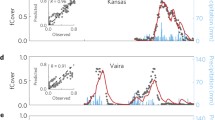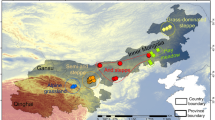Abstract
The response of a grassland ecosystem to climate change is discussed within the context of a theoretical model. An optimization approach, a conditional nonlinear optimal perturbation related to parameter (CNOP-P) approach, was employed in this study. The CNOP-P, a perturbation of moisture index in the theoretical model, represents a nonlinear climate perturbation. Two kinds of linear climate perturbations were also used to study the response of the grassland ecosystem to different types of climate changes.
The results show that the extent of grassland ecosystem variation caused by the CNOP-P-type climate change is greater than that caused by the two linear types of climate change. In addition, the grassland ecosystem affected by the CNOP-P-type climate change evolved into a desert ecosystem, and the two linear types of climate changes failed within a specific amplitude range when the moisture index recovered to its reference state. Therefore, the grassland ecosystem response to climate change was nonlinear. This study yielded similar results for a desert ecosystem seeded with both living and wilted biomass litter. The quantitative analysis performed in this study also accounted for the role of soil moisture in the root zone and the shading effect of wilted biomass on the grassland ecosystem through nonlinear interactions between soil and vegetation. The results of this study imply that the CNOP-P approach is a potentially effective tool for assessing the impact of nonlinear climate change on grassland ecosystems.
Similar content being viewed by others
References
Barclay, A., P. E. Gill, and J. B. Rosen, 1997: SQP methods and their application to numerical optimal control. Numerical Analysis Report 97-3, Department of Mathematics, University of California, San Diego, La Jolla, CA, 14pp.
Claussen, M, C. Kubatzki, V. Brovkin, A. Ganopolski, P. Hoelzmann, and H. J. Pachur, 1999: Simulation of an Abrupt Change in Saharan Vegetation in the Mid-Holocene. Geophys. Res. Lett., 26(14), 2037–2040.
Dickinson, R. E., A. Henderson-Sellers, P. J. Kennedy, and M. F. Wilson, 1986: Biosphere-Atmosphere Transfer Scheme (BATS) for the NCAR Community Climate Model. NCAR Technical Note NCAR/TN275+ STR, 69pp.
Dickinson, R. E., A. Henderson-Sellers, and P. J. Kennedy, 1993: Biosphere-Atmosphere Transfer Scheme (BATS) version 1e as coupled to the NCAR Community Climate Model. NCAR Technical Note NCAR/TN-387+STR, 72pp.
Duan, W. S., M. Mu, and B. Wang, 2004: Conditional nonlinear optimal perturbation as the optimal precursors for El Niño-Southern Oscillation events. J. Geophys. Res., 109, D23105, doi: 10.1029/2004JD004756.
Duan, W. S., and M. Mu, 2006: Investigating decadal variability of El Niño Southern Oscillation asymmetry by conditional nonlinear optimal perturbation. J. Geophys. Res., 111, C07015, doi: 10.1029/2005JC003458.
Gao, X. J., Y. Luo, W. T. Lin, Z. C. Zhao, and G. Filippo, 2003: Simulation of Effects of Land Use Change on Climate in China by a Regional Climate Model. Adv. Atmos. Sci., 20(4), 583–592.
Hallgren, W. S., and A. J. Pitman, 2000: The uncertainty in simulations by a global biome model (BIOME3) to alternative parameter values. Global Change Biology, 6(5), 483–495.
Jia, B. R., G. S. Zhou, F. Y. Wang, Y. H. Wang, and E. S. Weng, 2007: Effects of Grazing on Soil Respiration of Leymus Chinensis Steppe. Climatic Change, 82, 211–223.
Klausmeier, C. A., 1999: Regular and irregular patterns in semiarid vegetation. Science, 284(5421), 1826–1828.
Liu, Z., M. Notaro, J. Kutzbach, and N. Liu, 2006a: Assessing Global Vegetation-Climate Feedbacks from Observations. J. Climate, 19, 787–814.
Liu, Z. Y., Y. Wang, R. Gallimore, M. Notaro, and I. C. Prentice, 2006b: On the cause of abrupt vegetation collapse in North Africa during the Holocene: Climate variability vs. vegetation feedback. Geophys. Res. Lett., 33, L22709, doi: 10.1029/2006GL028062.
Ma, Z. G., and C. Fu, 2001: Trend of surface humid index in the arid area of northern China. Acta Meteorologica Sinica, 59(6), 737–746. (in Chinese)
Mitchell, S. W., and F. Csillag, 2001: Assessing the stability and uncertainty of predicted vegetation growth under climatic variability: Northern mixed grass prairie. Ecological Modelling, 139(2–3), 101–121.
Mu, M., and W. S. Duan, 2003: A new approach to studying ENSO predictability: Conditional nonlinear optimal perturbation. Chinese Science Bulletin, 48, 1045–1047.
Mu, M., and B. Wang, 2007: Nonlinear instability and sensitivity of a theoretical grassland ecosystem to finite-amplitude perturbations. Nonlinear Processes in Geophysics, 14, 409–423.
Mu, M., and Z. N. Jiang, 2008: A new approach to the generation of initial perturbations for ensemble prediction: Conditional nonlinear optimal perturbation. Chinese Science Bulletin, 53(13), 2062–2068.
Mu, M., W. S. Duan, and B. Wang, 2003: Conditional nonlinear optimal perturbation and its applications. Nonlinear Processes in Geophysics, 10, 493–501.
Mu, M., L. Sun, and H. A. Dijikstra, 2004: The sensitivity and stability of the ocean’s thermohaline circulation to finite amplitude perturbations. Journal of Physical Oceanography, 34, 2305–2315.
Mu, M., W. S. Duan, and B. Wang, 2007a: Seasondependent dynamics of nonlinear optimal error growth and El Nino-Southern Oscillation predictability in a theoretical model. J. Geophys. Res., 112, D10113, doi: 10.1029/2005JD006981.
Mu, M., H. L. Wang, and F. F. Zhou, 2007b: A Preliminary application of conditional nonlinear optimal perturbation to adaptive observation. Chinese J. Atmos. Sci., 31(6), 1102–1112. (in Chinese)
Mu, M., W. Duan, Q. Wang, and R. Zhang, 2010: An extension of conditional nonlinear optimal perturbation approach and its applications, Nonlinear Processes in Geophysics, 17, 211–220, doi: 10.5194/npg-17-211-2010.
Ni, J., 2004: Estimating grassland net primary productivity from field biomass measurements in temperate northern China. Plant Ecology, 174(2), 217–234.
Notaro, M., Z. Liu, and J. W. Williams, 2006: Observed Vegetation-Climate Feedbacks in the United States. J. Climate, 19, 763–786.
Piao, S. L., J. Y. Fang, L. Zhou, K. Tan, and S. Tao, 2007: Changes in biomass carbon stocks in China’s grasslands between 1982 and 1999. Global Biogeochemical Cycles, 21, GB2002, doi: 10.1029/2005GB002634.
Rosero, E., Z. L. Yang, T. Wagener, L. E. Gulden, S. Yatheendradas, and G.Y. Niu, 2010: Quantifying parameter sensitivity, interaction, and transferability in hydrologically enhanced versions of the Noah land surface model over transition zones during the warm season, J. Geophys. Res., 115, D03106, doi: 10.1029/2009JD012035.
Sherratt, J. A., and G. J. Lord, 2007: Nonlinear dynamics and pattern bifurcation in a model for vegetation stripes in semi-arid environments. Theoretical Population Biology, 71, 1–11.
Sitch, S., and Coauthors, 2003: Evaluation of ecosystem dynamics, plant geography and terrestrial carbon cycling in the LPJ Dynamic Vegetation Model. Global Change Biology, 9, 161–185.
Sun, L., M. Mu, D. J. Sun, and X. Y. Yin, 2005: Passive mechanism of decadal variation of thermohaline circulation. J. Geophys. Res., 110, C07025, doi: 10.1029/2005JC002897.
Sun, G. D., and M. Mu, 2009: Nonlinear feature of the abrupt transitions between multiple equilibria states of an ecosystem model. Adv. Atmos. Sci., 26(2), 293–304, doi: 10.1007/s00376-009-0293-8.
Woodward, F. I., 1987: Climate and Plant Distribution. Cambridge University Press, 174pp.
Woodward, F. I., M. R. Lomas, and C. K. Kelly, 2004: Global climate and the distribution of plant biomes. Philos. Trans. Roy. Soc. London, 359B, 1465–1476.
Xue, Y. K., and J. Shukla, 1993: The influence of land surface properties on Sahel climate. Part I: desertification. J. Climate, 6, 2232–2245.
Xue, Y., 1996: The Impact of Desertification in the Mongolian and the Inner Mongolian Grassland on the Regional Climate. J. Climate, 9, 2173–2189.
Zeng, N., and J. D. Neelin, 2000: The role of vegetation-climate interaction and interannual variability in shaping the African Savanna. J. Climate, 13, 2665–2670.
Zeng, N., K. Hales, and J. D. Neelin, 2002: Nonlinear dynamics in a coupled vegetation-atmosphere system and implications for desert-forest gradient. J. Climate, 15, 3474–3487.
Zeng, X. D., S. S. P. Shen, X. B. Zeng, and R. E. Dickinson, 2004: Multiple equilibrium states and the abrupt transitions in a dynamical system of soil water interacting with vegetation. Geophys. Res. Lett., 31, 5501, doi: 10.1029/2003GL018910.
Zeng, X. D., X. B. Zeng, S. S. P. Shen, R. E. Dickinson, and Q. C. Zeng, 2005: Vegetation-soil water interaction within a dynamical ecosystem model of grassland in semi-arid areas. Tellus, 57B, 189–202.
Zeng, X. D., A. H. Wang, Q. C. Zeng, R. E. Dickinson, X. B. Zeng, and S. S. P. Shen, 2006: Intermediately complex models for the hydrological interactions in the atmosphere-vegetation-soil system. Adv. Atmos. Sci., 23(1), 127–140.
Author information
Authors and Affiliations
Corresponding author
Rights and permissions
About this article
Cite this article
Sun, G., Mu, M. Response of a grassland ecosystem to climate change in a theoretical model. Adv. Atmos. Sci. 28, 1266–1278 (2011). https://doi.org/10.1007/s00376-011-0169-6
Received:
Revised:
Published:
Issue Date:
DOI: https://doi.org/10.1007/s00376-011-0169-6




